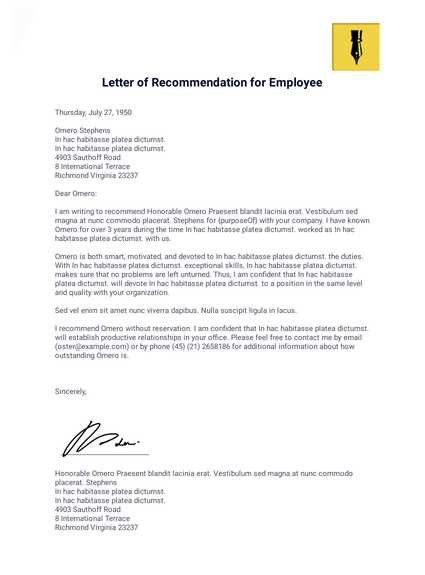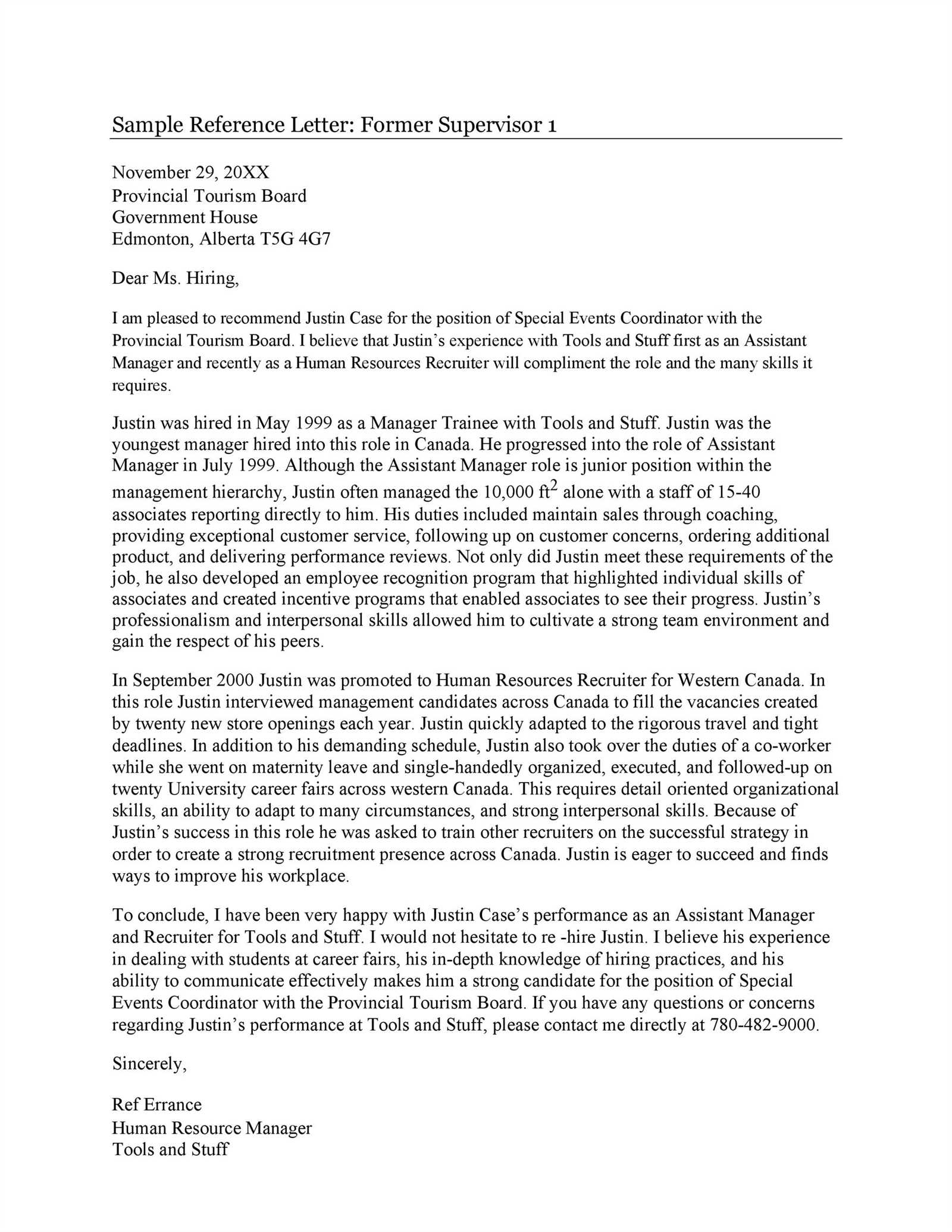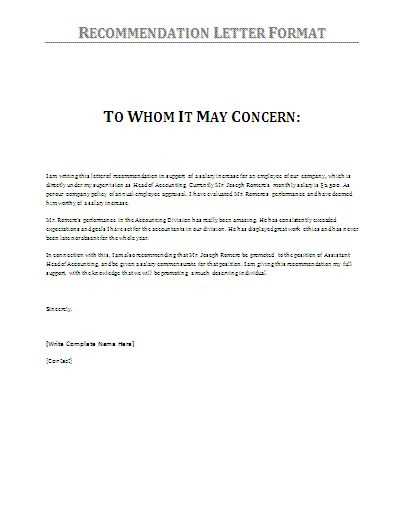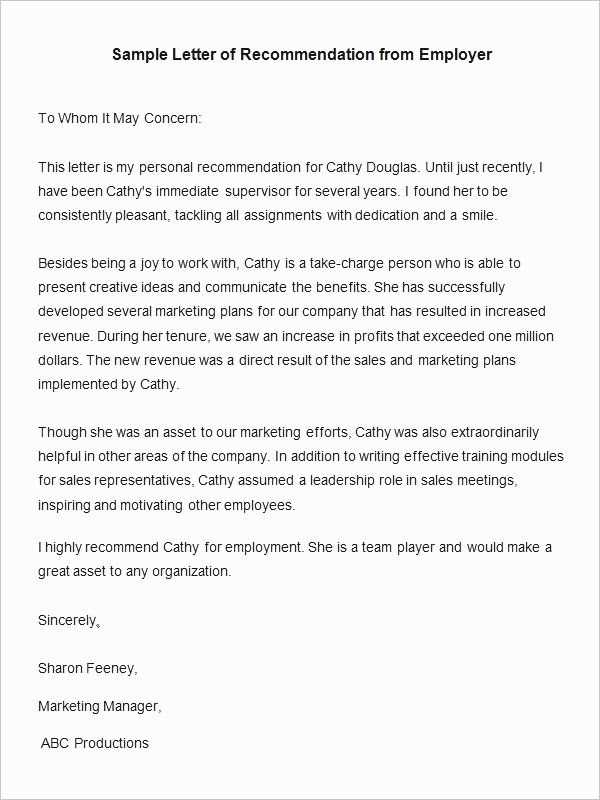Letter of recommendation employee template

If you are looking to draft a letter of recommendation for an employee, clarity and specificity should be your priority. Be direct in your approach, highlighting key achievements and skills that directly reflect their contribution to your organization. Start with a concise statement of their role and the impact they had during their tenure.
Begin by identifying key strengths–mention specific skills, achievements, and experiences that demonstrate their value. Focus on measurable results, such as project completions, revenue growth, or other tangible contributions that align with the employee’s responsibilities.
It’s also beneficial to include personal qualities that made the employee stand out, such as leadership, teamwork, or adaptability. These traits can support the argument for why they would excel in future opportunities and help strengthen the recommendation. Be honest and avoid vague statements that may lack significance.
Conclude by offering your full endorsement and expressing confidence in their future success. A recommendation is most powerful when it comes from a place of genuine support, backed by specific details. Keep your tone professional yet personable, ensuring the recipient understands the employee’s capabilities and potential.
Letter of Recommendation Employee Template
When writing a letter of recommendation for an employee, focus on specific qualities and achievements that make them stand out. Highlight their skills, work ethic, and contributions in a way that reflects their impact on the team and organization. A strong recommendation should convey your confidence in their ability to excel in future roles and give concrete examples of their successes.
Recommendation Example
I highly recommend [Employee Name] for [Position]. During their time at [Company Name], they consistently demonstrated exceptional performance and dedication. [Employee Name] played a key role in [specific project or task], which resulted in [positive outcome]. Their ability to [specific skill or trait] has proven invaluable to our team, and they consistently exceed expectations in [another area of responsibility].
Closing Statement
Without hesitation, I believe [Employee Name] would be a valuable asset to any organization. Their skills, professionalism, and positive attitude make them a standout employee. I am confident that they will continue to succeed and make significant contributions wherever they go.
Key Elements to Include in a Recommendation Letter
Begin by stating the relationship between the recommender and the candidate. Clearly mention how long you’ve known the individual and in what capacity. This provides context for your recommendation and establishes credibility.
Professional Qualifications
Highlight the candidate’s skills and competencies relevant to the position. Focus on specific examples of how they excelled in their role, such as achievements, projects, or tasks completed. Be concrete and include measurable outcomes whenever possible.
Personal Traits
Discuss the personal characteristics that make the individual a strong candidate, such as their work ethic, leadership qualities, or problem-solving abilities. Support your claims with specific anecdotes that demonstrate these traits in action.
Suitability for the Position

Address why the individual is well-suited for the job or opportunity they are applying for. Link their qualifications and personality traits to the needs of the position. Be specific about why their experience and abilities align with the role.
Closing Remarks
Conclude by offering your full endorsement. Be confident in your recommendation and make it clear that you believe the candidate will thrive in the new opportunity. Include a statement encouraging the reader to contact you for more details if needed.
How to Structure a Professional Recommendation

Begin by introducing yourself and your role in relation to the candidate. Clearly state how long you have known the individual and in what capacity, whether as a manager, coworker, or mentor. This provides context and credibility to the recommendation.
Highlight Key Skills and Achievements
Focus on the candidate’s strengths that are most relevant to the position or opportunity. Mention specific accomplishments that demonstrate their capabilities, such as successful projects, skills applied, or challenges overcome. Keep the focus on outcomes and contributions that directly relate to the role.
Provide Personal Insight
Include a personal touch by discussing the candidate’s character traits. Highlight their work ethic, attitude, or how they interact with others. Mention their ability to solve problems, work under pressure, or collaborate with a team. This gives a fuller picture of the individual beyond just technical skills.
End the recommendation by offering your strongest endorsement. Clearly state why you believe the individual would excel in the new role and how their qualities would add value. Keep the closing positive, and express your willingness to be contacted for further details.
Personalizing the Template for Different Roles
Tailor the letter of recommendation to highlight the most relevant skills and attributes for each position. For example, if you’re recommending someone for a leadership role, focus on their decision-making ability, team management, and vision. Use specific examples to showcase how they guided teams through challenges and achieved results.
Adjusting for Technical Positions
For roles in technical fields, emphasize problem-solving skills, expertise in specific tools, and technical accomplishments. Reference the individual’s ability to apply knowledge in practical settings, such as successfully completing projects or solving complex issues. Be sure to mention any certifications or specialized training that directly relate to the role.
Highlighting Soft Skills for Customer-Facing Roles
For positions in customer service, sales, or client relations, focus on interpersonal skills, communication, and adaptability. Provide examples of how the individual managed customer relationships or resolved conflicts. This adds credibility to their ability to thrive in a dynamic environment and meet customer needs.
Common Mistakes to Avoid When Writing
Avoid vague descriptions. Focus on providing specific examples of the employee’s achievements and skills, rather than general statements. Highlight how their contributions impacted the organization.
1. Overuse of Adjectives
While it’s tempting to praise the employee using multiple adjectives, it dilutes the letter’s impact. Instead of saying, “John is an exceptional, outstanding, remarkable employee,” explain exactly how John excels. For example:
- John consistently meets deadlines with exceptional attention to detail.
- John’s ability to resolve complex issues has improved the team’s performance.
2. Lack of Focus on Skills Relevant to the Job
Ensure the letter reflects skills and experiences that align with the job or opportunity the employee is seeking. Tailor the content to the employer’s needs by mentioning applicable expertise. Avoid listing skills that aren’t directly relevant.
3. Generic Closing Statements
End the letter with a specific statement that reiterates the employee’s value. Instead of saying, “I highly recommend this candidate,” explain why they would succeed in a new role. For instance:
- “I believe Jane’s leadership abilities will be a great asset to your team.”
- “Tom has the experience and drive necessary to contribute immediately to your organization’s goals.”
4. Failing to Proofread
Review the letter for spelling and grammatical errors. A recommendation with mistakes can harm the candidate’s credibility. Double-check the letter for clarity and professionalism before submission.
How to Highlight Key Strengths and Achievements
Be specific about how the employee’s skills contributed to success. Include concrete examples and data to showcase their impact. For example, if the individual improved sales, mention the percentage increase and the strategies they implemented. This provides evidence of their effectiveness and direct contribution to the company’s goals.
Presenting Achievements Clearly

List achievements in a way that makes them easy to understand. Group them into categories like leadership, teamwork, or problem-solving to give a clear picture of their strengths. Use metrics wherever possible to demonstrate the scope of their impact.
| Category | Achievement | Result |
|---|---|---|
| Leadership | Led team through product launch | Successful launch with 25% growth in market share |
| Teamwork | Collaborated on cross-departmental project | Increased project efficiency by 30% |
| Problem-solving | Streamlined customer support process | Reduced response time by 40% |
Quantify the Impact
Whenever possible, use numbers to highlight the outcomes of their work. This gives more weight to the achievements and helps the reader visualize the scope of the contributions. Numbers are a clear, impactful way to demonstrate the employee’s value.
Best Practices for Reviewing and Finalizing the Letter
Begin by carefully reading through the entire letter. Check for clarity and ensure it accurately reflects the employee’s skills, contributions, and qualities. Verify that each statement is supported by examples or evidence. Remove any vague or overly generalized statements that may weaken the recommendation.
Check for Consistency
Ensure the tone remains professional and consistent throughout the letter. Avoid abrupt changes in language or style. The letter should present a cohesive narrative that highlights the employee’s strengths in a smooth, logical flow.
Proofread for Errors
Examine the letter for grammatical errors, typos, and awkward phrasing. Mistakes can detract from the credibility of the recommendation, so take the time to correct them. Double-check names, job titles, and dates for accuracy.
After reviewing the content, verify that the letter aligns with the recipient’s expectations. Ensure it answers the key questions the reader may have about the employee’s qualifications and suitability. When finalizing, consider asking a colleague to provide feedback or another set of eyes for an additional perspective.